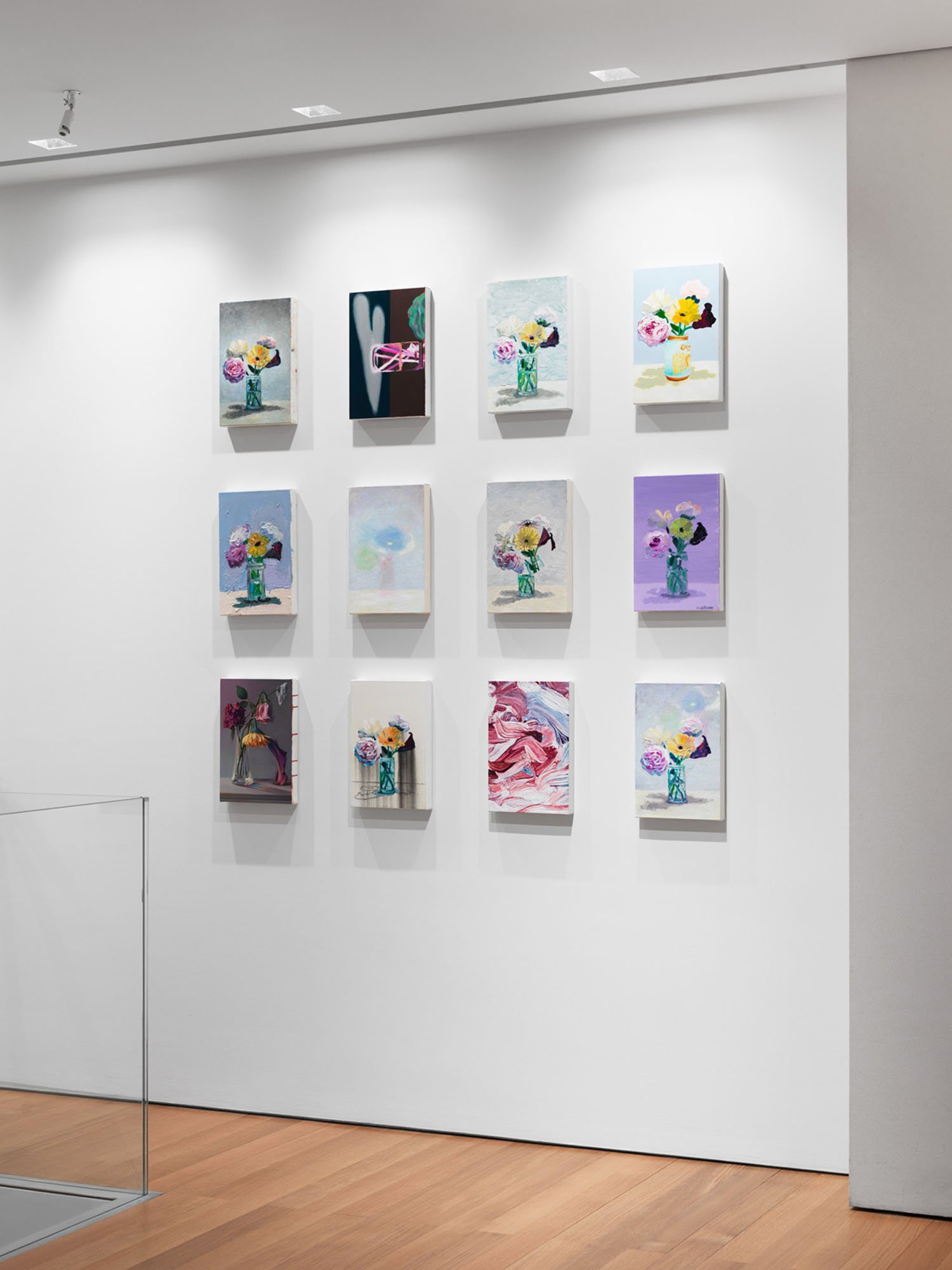Cynthia Daignault:
There is nothing I could say that I haven’t thought before
JANUARY 19 - MAY 13, 2017
Cynthia Daignault’s new series of paintings—part solo exhibition, virtual group show, and curatorial project—is a collaboration with 36 artists exploring ideas of agency, appropriation, and the traces we leave behind. In collaboration with Cory Arcangel, Conor Backman, Sadie Barnette, Jason Bereswill, Todd Bienvenu, Carol Bove, Canyon Castator, Sara Cwynar, Andy Coolquitt, TM Davy, Peter Dreher, Jessica Eaton, Gregory Edwards, Awol Erizku, Roe Ethridge, Robert Gober, Josephine Halvorson, Anthea Hamilton, Matthew Hansel, Peter Harkawik, Daniel Heidkamp, Matthew Higgs, Jim Hodges, John Houck, Paul Jacobsen, Jeff Koons, Barbara Kruger, Louise Lawler, Margaret Lee, Chason Matthams, Allan McCollum, Josephine Meckseper, Jonathan Monk, Roula Partheniou, Richard Phillips, Charles Ray, Magali Reus, Jenna Rosenberg, Ed Ruscha, Tom Sachs, Erin Shirreff, Lorna Simpson, Tristan Unrau, Dylan Vandenhoeck, Julia Wachtel, Stanley Wolukau-Wanambwa, Fred Wilson, and Letha Wilson.
Daignault has experimented with collaboration throughout her career, often asking artists, curators, and volunteers to share in the creation of her work. In that spirit, she initiated this exhibition at FLAG, inviting artists who explore themes of appropriation, readymades, and display to participate in a group show, where she would make and exhibit painted copies of their works in lieu of the actual objects. As it is now more common to encounter a digital surrogate than a physical artwork, Daignault painted from JPEGs, rendering the simulacra as paintings. The artist suggests that: “To make any copy is to perform a shadow dance where the artist mimics and mirrors their subject.”
At the heart of each artwork is an act of appropriation, yet one in which Daignault has re-empowered the artists being referenced by granting them the permission to say no and the agency to choose. She recasts appropriation as collaboration and reverses the power dynamic of a nihilistic approach where all images are rights-free and up for grabs. Each finished painting is a hybrid of two practices and styles—an exchange between artists—a fact Daignault highlights by giving the artists a small painted copy of their work. The artist continues her use of serial forms, with these works all created in traditional portrait scale, and presented in a linear non-hierarchical installation, forging meaning across the group of images as a whole.
There is nothing I could say that I haven’t thought before was originally presented at Stems Gallery in Brussels, Belgium, just after the terrorist attacks in 2016, which brought all of Belgium to a standstill. With the opportunity to bring the project to New York, Daignault expanded the exhibition from 20 to 36 artworks. This exhibition is the first time the entire series of works will be shown together.
In the adjacent galleries, Daignault will debut two new bodies of work that emanate from similar themes:
MoMA, 2017, is a depiction of the 30 most iconic paintings in the permanent collection of the Museum of Modern Art, New York, as collected and sourced by Daignault from catalogues, magazines, top-ten lists, websites, and social media. Installed in a grid, the work is a portrait of an institution, not only distilling its permanent collection to color and content, but revealing an overwhelmingly historical bias toward male painters – there are no women represented here. Beyond the objective, the short and poetic texts on each of the individual paintings relay the subjective interiority of one artist’s experience of these works. MoMA, 2017, highlights the tension between Daignault’s experience as a female painter and the history and present of the medium.
The Certainty of Others, 2017, includes 12 contemporary representational painters who were invited by Daignault to each produce a surrogate of her still life Everyone you ever loved will someday die, 2015, which was destroyed last year and exists only in image and memory. An inverse of the main gallery exhibition, in which a broad spectrum of work is filtered through one artist, this 12-part installation takes one artist’s work and expands it horizontally. For this piece, Daignault chose to work with peers and men, in an enactment of collaborative consent. The work explores the connections between painters, creating a multipartite portrait of one painting.
A series of events, including an artist talk with Daignault, and performances with Brooklyn-based artist David Kennedy Cutler and the Brussels-based dancer and choreographer Vera Tussing occur throughout the run of the exhibition.
About:
Cynthia Daignault (b. 1978, Baltimore, MD) is an artist living and working in Baltimore, MD, and New York, NY. Daignault received a BA from Stanford University, Stanford, CA, in 2001, was a MacDowell Colony Fellow, and was the recipient of a Rema Hort Mann Foundation Grant. She has been the subject of numerous solo exhibitions, including There is nothing I could say that I haven’t thought before, Stems Gallery, Brussels, Belgium (2016); Light Atlas, Lisa Cooley, New York, NY (2015); Home, This must be the place, Rowhouse Project, Baltimore, MD (2015); among others. Her paintings have been included in major museum group exhibitions, including at the Museum of Contemporary Art Denver (2015); the Fort Worth Modern (2014); the Brooklyn Museum (2014); and many others. In 2017, Daignault will be exhibiting at The Metropolitan Museum of Art, New York, NY; MASS MOCA, North Adams, MA; Capital Gallery, San Francisco, CA; and the Herron Museum of Art, Indianapolis, IN.
“Via the three complementary series on show here, Cynthia Daignault proposes a form of conceptual painting that doesn’t abandon craft, and even has room to reinvigorate fusty genre mainstays like the floral still life. The result is an exhibition that is cerebral without being obtuse—and one that offers a way forward for artists who want to push the medium without murdering it outright.”
— Scott Indrisek, Art Review









